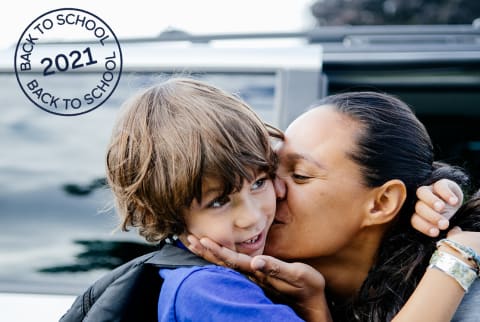Advertisement
I'm A Parenting Expert & Here Are The Tips I'm Giving Every Parent This School Year


What effect will the delta variant have on our children's school year? Will masks continue, and if so, will they negatively affect children socially? With the return to in-person school in many states or continued social distance, we as adults are exhausted and besieged by worry and anticipation, yet we do our best to put on a brave face to prepare our children for another back to school "non-normal" semester.
Social distancing's impact on your child.
Of course, we need to keep our children, families, and one another safe. Given this, social distancing has been a necessity in many cases—even if it comes with some drawbacks for child development.
Children have missed milestones and experiences that are needed to prepare them for new horizons. The preschooler or the kindergartner who will be entering first grade will not have learned key instructions such as how to walk through halls with their hands by their sides.
Some children now avoid social encounters despite having begged for playdates over the past 18 months. Others seem content to wear their PJs as attire, while others struggle with the transition between activities because recent life did not require a shift from the Lego tower to math class.
How to prepare your child to reenter school this fall.
Here's the advice I'm giving parents this fall:
Help them move forward.
There is a misnomer out there that kids will just "reengage" into their past lives, but how do we know that for sure? Shifts have occurred and due to skill gaps. It may be best to look for new routines rather than automatically going back to old ones. Collaborate with your child to walk through expectations, needs, and routines.
Create plans.
Once you know the particulars of the school's rules—and when they change—share them with your child. Will there be a mask mandate? What are the expectations regarding social distancing? Co-create a before- and after-school plan with your child that addresses these procedures. This will help to reduce their anxiety, especially as guidelines shift and change as the school year goes on, and help with time management. Factor in extra time, create a timeline, and do a dry run—even if your child was an ace at heading off to school before.
Prepare, preview, and problem-solve.
Previewing what school may look like can help your child process worries and problem-solve potential hurdles. Ask what they are looking forward to and what they are worried about.
Help them build future thinking by visualizing the morning, the class, and the routine. Role-play and act it out. If you cannot visit the school, then show pictures online, show the outside of the school, and ask friends and siblings to fill in some information for your child.
Schedule fun, passion, and interest.
Although the start of school may feel dreary, our need to look forward to fun is even more essential. Kids may be in masks during the day, but outside of school can be a time to explore the things that make this all worth it. Collaborate to identify passions and interests, then create a plan A and plan B for different possible scenarios and for the shifts in the school year due to the COVID-19 pandemic. Try to help your child plan and have fun and joy and breaks so they have something to look forward to that feeds their interest and passion.
Prepare for anxiety.
As this pandemic stretches on and on, your child may experience anxiety. Project a sense of confidence and understanding while not minimizing their worries. Their concerns are real, and we as parents need to ask questions and listen intently. Empathy goes a long way. Start the transition with small steps. Drive past the school, shop together for new school supplies and clothing, and plan lunches. Children with anxiety often lack problem-solving skills and doubt themselves. For larger issues, see if together you can problem-solve.
Don't surrender the conversation.
Uncomfortable conversations are just that—uncomfortable. Our kids don't want to talk to us, yet we know we need to address the root of the problem. Start with stepping into your kid's shoes to explore the concerns. When we really explore their concerns, it does wonders for everyone. Don't miss this opportunity by surrendering the conversation. If children are shrugging, quiet, or avoiding engagement, ask open questions. Try "What are you looking forward to?" and "What was fun about school before?" Don't lecture or have big conversations. Instead, have small, quick check-ins.
Facilitate reconnecting with friends.
Dust off social skills before school returns, and set up a few socially distanced playdates with friends now—especially those who will be in your child's class. Meeting up before school starts can help your child assuage anxiety. Knowing someone who will be in their class will make the transition a little easier.
Navigating playdates when skills are rusty.
A year without playdates has made social interactions more challenging for all children, especially those with existing social challenges. Playdates are a way for kids to practice and reengage, but many children are struggling now due to the lack of connection, lagging maturity, and fewer social models. Social distancing has made playdates even more valuable, yet they may take a bit more orchestration. When choosing playdates, aim for a friend whose temperament is similar to your child's. This will provide a chance to play better and help your child practice the social behaviors they are working on. Care should be taken when selecting this peer, as too much similarity, e.g., two bossy kids, may actually induce arguments. Now is the time to provide children with extra support to build back lagging social-emotional learning skills. The good news is that like any skill, these can be taught and improved.
Detect your child's gaps.
Our environment, circumstances, peers, and role models shape how we learn. After months of home-schooling and social distancing, children may have developed gaps in their social skills. Peers, interactive play, and the reciprocal nature of being with others are how children learn new social, emotional, and life skills. Figure out where your child needs support by working collaboratively with their teacher. Look at past assessments and identify what skills they need to work on now. Share with your child these expectations and then partner on ways to move forward.
Practice skills at home.
To help your child experience social learning, first model the desired skill or behavior and then actively engage in situations where they can practice this new skill. Play board games, engage in conversations, ask them to share with siblings, prompt them to read the room, and interpret daily situations so they can generalize the skills and demonstrate them with a playmate.
Parents are the biggest role models for children. We need to be mindful of our own emotions in order to be present for our children. It is OK to express concerns and worry, but we must try to remain calm. Self-care is essential. Deep breaths, bathroom breaks, exercise, or stepping outside can help regulate feelings. This is not only important for you as a parent, but it also shows your child that you have strategies to take care of yourself.
Watch Next
Enjoy some of our favorite clips from classes
Enjoy some of our favorite clips from classes
What Is Meditation?
Mindfulness/Spirituality | Light Watkins
Box Breathing
Mindfulness/Spirituality | Gwen Dittmar
What Breathwork Can Address
Mindfulness/Spirituality | Gwen Dittmar
The 8 Limbs of Yoga - What is Asana?
Yoga | Caley Alyssa
Two Standing Postures to Open Up Tight Hips
Yoga | Caley Alyssa
How Plants Can Optimize Athletic Performance
Nutrition | Rich Roll
What to Eat Before a Workout
Nutrition | Rich Roll
How Ayurveda Helps Us Navigate Modern Life
Nutrition | Sahara Rose
Messages About Love & Relationships
Love & Relationships | Esther Perel
Love Languages
Love & Relationships | Esther Perel
What Is Meditation?
Box Breathing
What Breathwork Can Address
The 8 Limbs of Yoga - What is Asana?
Two Standing Postures to Open Up Tight Hips
How Plants Can Optimize Athletic Performance
What to Eat Before a Workout
How Ayurveda Helps Us Navigate Modern Life
Messages About Love & Relationships
Love Languages
Advertisement

The 4 Pillars That Lead To Long-Lasting Relationships, From A Marriage Counselor
Rachel Glik, Ed.D., LPC

The 4 Pillars That Lead To Long-Lasting Relationships, From A Marriage Counselor
Rachel Glik, Ed.D., LPC









